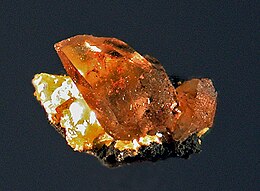Terlinguaite
| Terlinguaite | |
|---|---|
 Terlinguaite, collected from Mariposa Mine, Terlingua District, Brewster County, Texas, United States | |
| General | |
| Category | Halide mineral |
| Formula (repeating unit) | Hg2ClO |
| Strunz classification | 3.DD.20 |
| Crystal system | Monoclinic |
| Crystal class | Prismatic (2/m) (same H-M symbol) |
| Space group | C2/c |
| Unit cell | a = 19.51 Å, b = 5.91 Å c = 9.47 Å; β = 143.81°; Z = 4 |
| Identification | |
| Color | Sulfur-yellow, greenish yellow, brown |
| Crystal habit | Aggregates of equant to elongated crystals, powdery, massive |
| Cleavage | Perfect on [101] |
| Tenacity | Brittle |
| Mohs scale hardness | 2.5 |
| Luster | Brilliant adamantine |
| Streak | Lemon-yellow, turning olive-green |
| Diaphaneity | Transparent to translucent |
| Specific gravity | 9.22 |
| Optical properties | Biaxial (-) |
| Refractive index | nα = 2.350 nβ = 2.640 nγ = 2.660 |
| Birefringence | δ = 0.310 |
| Pleochroism | Weak, green and yellow |
| 2V angle | Measured: 20° |
| Alters to | turns olive-green on exposure to light |
| References | [1][2][3] |
Terlinguaite is the naturally occurring mineral with formula Hg2ClO. It is formed by the weathering of other mercury-containing minerals. It was discovered in 1900 in the Terlingua District of Brewster County, Texas, for which it is named.[4] Its color is yellow, greenish yellow, brown, or olive green.
References[]
| Wikimedia Commons has media related to Terlinguaite. |
- ^ Handbook of Mineralogy
- ^ Mindat.org
- ^ Webmineral data
- ^ Hillebrand, W. F.; W. T. Schaller (1907). "Art. XXVI. "The Mercury Minerals from Terlingua, Texas: Kleinite, Terlinguaite, Eglestonite, Montroydite, Calomel, Mercury"". The American Journal of Science (139): 259–274. doi:10.2475/ajs.s4-24.141.259. Retrieved 2009-05-21.
Categories:
- Mercury minerals
- Halide minerals
- Geology of Texas
- Oxychlorides
- Monoclinic minerals
- Minerals in space group 15
- Halide mineral stubs